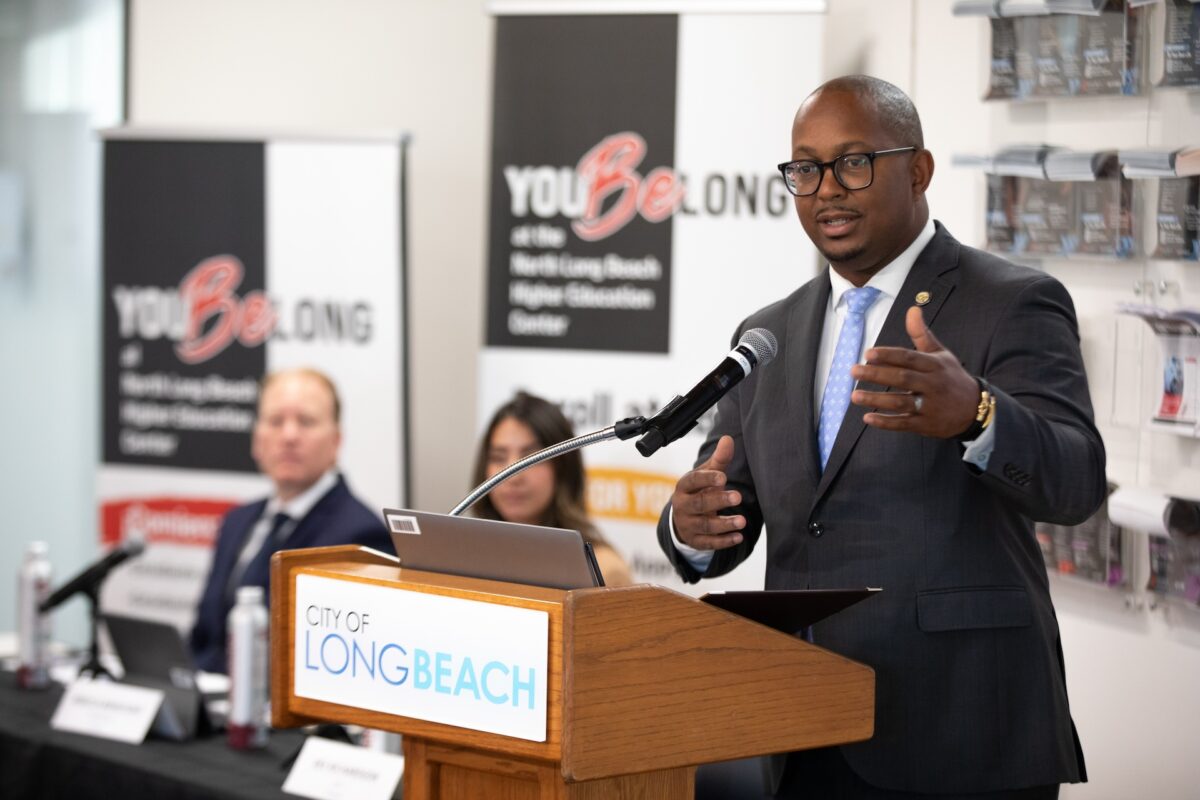With the state facing an enormous budget deficit and federal cuts looming, Long Beach proposed a lean 2026 budget that still sets aside money for those impacted by recent immigration raids and a continued homelessness crisis.
As part of a $3.7 billion spending plan unveiled Thursday, Mayor Rex Richardson suggested the city reserve $5 million for assistance and legal defense for those facing the specter of deportation or federal cuts that could put more people on the streets.
“We don’t want people to have to choose between health care or paying the rent or making a choice between going to work or the risk of potentially being separated from their families,” Richardson said at a budget unveiling Thursday.
The package, titled “Defending Our Long Beach Values Plan,” will include $1.85 million in direct legal support through the existing Long Beach Justice Fund, about $500,000 in emergency cash and rent subsidies for immigrant families, and $150,000 to establish a program that educates businesses about undocumented workers’ rights. The other $2.5 million will go toward an eviction protection fund, meant to help anyone – not just immigrant families – affected by the federal administration’s policies or cuts.
Immigration legal defense would be provided by Western State College of Law and Esperanza Immigrant Rights Projects, both of which have been on the city’s retainer since January. The city also initiated a bid request two weeks ago for their permanent replacement.
Those two providers, along with the city’s office of equity, will vet those seeking legal assistance and accept referrals from the city’s community groups, including Órale. About $950,000 of the justice fund carried over from the last budget, leaving the fund at its highest total since it was established in 2018, officials said.
In another budget initiative, Richardson proposed allocating $500,000 for a tariff relief fund that could be doled out in one-time grants to cover local businesses’ increased costs from President Donald Trump’s trade policies.
Richardson also recommends policy changes in response to the immigration raids. The mayor asked that the city further restrict access within city-owned property by designating some areas as “non-public secure locations.” These restrictions, typically used by businesses, would be used to limit access by federal agents on city property without a warrant in hand, as allowed under state and federal law.
Signage on doors and other entryways would be present if this took effect, and staff would be trained to handle situations where federal immigration agents attempt to enter city property.
He also recommends establishing a new legal reserve for the city attorney’s office to defend against legal challenges from the Trump Administration and pay for ongoing litigation costs. The City Council recently voted to join a lawsuit arguing immigration agents are violating people’s civil rights.
His proposals would also establish disciplinary policies for city employees who do not adhere to Long Beach’s sanctuary city law, called the Long Beach Values Act. He recommended establishing pathways for “warnings, suspensions, demotions, or dismissals” to ensure full compliance. The plan also calls for an online portal where residents can report city employees they believe aren’t following the rules.
Vendors contracted with the city who do not follow its sanctuary policies may be disqualified from future contracts.
The mayor also recommended the city use $16 million from the new LA County Measure A sales tax, as well as money from the Los Angeles County Affordable Housing Solutions Agency, or LACAHSA, to pay for several housing and homelessness initiatives focused on preventing people from losing their homes.
In future years, the county measure, passed last November, is expected to net $24 million annually for Long Beach.
These include shallow rental subsidies for the seniors and other homelessness prevention programs.
It comes as the city enters a budget season with a $16.9 million deficit stoked by declining oil revenues, rising pension costs, a slowdown in consumer spending, a city and county sales tax expected to stagnate and uncertainty over the future of grants by the state and federal government. The city has proposed covering this year’s gap with one-time funding.
Over the next three months, leaders will deliberate how to shave down the shortfall and handle structural deficits in upcoming years, be it through cutting one-time investments, capital projects or ending pandemic-era programs that have outlived their use.
“We have to look at some programs that, you know, may be very popular or maybe exciting, but they were designed to be one-time coming out of the pandemic,” said City Manager Tom Modica. “They were designed to go away. And so we have to make some of those tough choices and sunset those but try to preserve the ones that we really need to preserve.”
But city officials kept an optimistic tone through their unveiling on Thursday morning, saying the city’s woes, with some savvy budgeting, are more than manageable. Modica pointed out that the city’s general fund deficit is 2.6%. The city of Los Angeles, by comparison, is 12.5% in the red, facing a billion-dollar deficit.
The City Council’s budget meetings start July 29 with the city’s three-member Budget Oversight Committee. Following that, there will be six city community budget meetings and five public hearings. Community meetings will vary in location. For more information, including dates and how to make public comments, visit here.
Editor’s note: The deficit number and Justice Fund carryover number were incorrect in an earlier version of this article.

